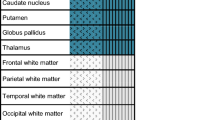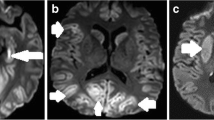Abstract
Background
The ability to predict outcomes in acutely comatose cardiac arrest survivors is limited. Brain diffusion-weighted magnetic resonance imaging (DWI MRI) has been shown in initial studies to be a simple and effective prognostic tool. This study aimed to determine the predictive value of previously defined DWI MRI thresholds in a multi-center cohort.
Methods
DWI MRIs of comatose post-cardiac arrest patients were analyzed in this multi-center retrospective observational study. Poor outcome was defined as failure to regain consciousness within 14 days and/or death during the hospitalization. The apparent diffusion coefficient (ADC) value of each brain voxel was determined. ADC thresholds and brain volumes below each threshold were analyzed for their correlation with outcome.
Results
125 patients were included in the analysis. 33 patients (26 %) had a good outcome. An ADC value of less than 650 × 10−6 mm2/s in ≥10 % of brain volume was highly specific [91 % (95 % CI 75–98)] and had a good sensitivity [72 % (95 % CI 61–80)] for predicting poor outcome. This threshold remained an independent predictor of poor outcome in multivariable analysis (p = 0.002). An ADC value of less than 650 × 10−6 mm2/s in >22 % of brain volume was needed to achieve 100 % specificity for poor outcome.
Conclusions
In patients who remain comatose after cardiac arrest, quantitative DWI MRI findings correlate with early recovery of consciousness. A DWI MRI threshold of 650 × 10−6 mm2/s in ≥10 % of brain volume can differentiate patients with good versus poor outcome, though in this patient population the threshold was not 100 % specific for poor outcome.


Similar content being viewed by others
References
Bassetti C, Bomio F, Mathis J, Hess CW. Early prognosis in coma after cardiac arrest: a prospective clinical, electrophysiological, and biochemical study of 60 patients. J Neurol Neurosurg Psychiatry. 1996;61:610–5.
Levy DE, Bates D, Caronna JJ, et al. Prognosis in nontraumatic coma. Ann Intern Med. 1981;94:293–301.
Levy DE, Caronna JJ, Singer BH, Lapinski RH, Frydman H, Plum F. Predicting outcome from hypoxic-ischemic coma. JAMA. 1985;253:1420–6.
Lown B. Sudden cardiac death—1978. Circulation. 1979;60:1593–9.
Cummins RO, Ornato JP, Thies WH, Pepe PE. Improving survival from sudden cardiac arrest: the “chain of survival” concept. A statement for health professionals from the advanced cardiac life support subcommittee and the emergency cardiac care committee, American Heart Association. Circulation. 1991;83:1832–47.
Go AS, Mozaffarian D, Roger VL, et al. Heart disease and stroke statistics–2013 update: a report from the American Heart Association. Circulation. 2013;127:e6–245.
Hamel MB, Phillips R, Teno J, et al. Cost effectiveness of aggressive care for patients with nontraumatic coma. Crit Care Med. 2002;30:1191–6.
Zandbergen EG, Hijdra A, Koelman JH, et al. Prediction of poor outcome within the first 3 days of postanoxic coma. Neurology. 2006;66:62–8.
Neumar RW, Nolan JP, Adrie C, et al. Post-cardiac arrest syndrome: epidemiology, pathophysiology, treatment, and prognostication. A consensus statement from the International Liaison Committee on Resuscitation (American Heart Association, Australian and New Zealand Council on Resuscitation, European Resuscitation Council, Heart and Stroke Foundation of Canada, InterAmerican Heart Foundation, Resuscitation Council of Asia, and the Resuscitation Council of Southern Africa); the American Heart Association Emergency Cardiovascular Care Committee; the Council on Cardiovascular Surgery and Anesthesia; the Council on Cardiopulmonary, Perioperative, and Critical Care; the Council on Clinical Cardiology; and the Stroke Council. Circulation. 2008;118:2452–83.
Stub D, Bernard S, Duffy SJ, Kaye DM. Post cardiac arrest syndrome: a review of therapeutic strategies. Circulation. 2011;123:1428–35.
Samaniego EA, Persoon S, Wijman CA. Prognosis after cardiac arrest and hypothermia: a new paradigm. Curr Neurol Neurosci Rep. 2011;11:111–9.
Al Thenayan E, Savard M, Sharpe M, Norton L, Young B. Predictors of poor neurologic outcome after induced mild hypothermia following cardiac arrest. Neurology. 2008;71:1535–7.
Samaniego EA, Mlynash M, Caulfield AF, Eyngorn I, Wijman CA. Sedation confounds outcome prediction in cardiac arrest survivors treated with hypothermia. Neurocrit Care. 2011;15:113–9.
Oddo M, Rossetti AO. Early multimodal outcome prediction after cardiac arrest in patients treated with hypothermia. Crit Care Med. 2014;42:1340–7.
Oddo M, Rossetti AO. Predicting neurological outcome after cardiac arrest. Curr Opin Crit Care. 2011;17:254–9.
Rossetti AO, Oddo M, Logroscino G, Kaplan PW. Prognostication after cardiac arrest and hypothermia: a prospective study. Ann Neurol. 2010;67:301–7.
Lovblad KO, Wetzel SG, Somon T, et al. Diffusion-weighted MRI in cortical ischaemia. Neuroradiology. 2004;46:175–82.
Wu O, Sorensen AG, Benner T, Singhal AB, Furie KL, Greer DM. Comatose patients with cardiac arrest: predicting clinical outcome with diffusion-weighted MR imaging. Radiology. 2009;252:173–81.
Wijman CA, Mlynash M, Caulfield AF, et al. Prognostic value of brain diffusion-weighted imaging after cardiac arrest. Ann Neurol. 2009;65:394–402.
Wijdicks EF, Campeau NG, Miller GM. MR imaging in comatose survivors of cardiac resuscitation. AJNR Am J Neuroradiol. 2001;22:1561–5.
Greer DM. MRI in anoxic brain injury. Neurocrit Care. 2004;1:213–5.
Barrett KM, Freeman WD, Weindling SM, et al. Brain injury after cardiopulmonary arrest and its assessment with diffusion-weighted magnetic resonance imaging. Mayo Clin Proc. 2007;82:828–35.
Reese TG, Heid O, Weisskoff RM, Wedeen VJ. Reduction of eddy-current-induced distortion in diffusion MRI using a twice-refocused spin echo. Magn Reson Med. 2003;49:177–82.
Moseley ME, Cohen Y, Kucharczyk J, et al. Diffusion-weighted MR imaging of anisotropic water diffusion in cat central nervous system. Radiology. 1990;176:439–45.
Harris PA, Taylor R, Thielke R, Payne J, Gonzalez N, Conde JG. Research electronic data capture (REDCap)–a metadata-driven methodology and workflow process for providing translational research informatics support. J Biomed Inform. 2009;42:377–81.
ROC analysis: web-based calculator for ROC curves. http://www.jrocfit.org (2014).
Mlynash M, Campbell DM, Leproust EM, et al. Temporal and spatial profile of brain diffusion-weighted MRI after cardiac arrest. Stroke. 2010;41:1665–72.
Hirsch KG, Mlynash M, Jansen S, et al. Prognostic value of a qualitative brain MRI scoring system after cardiac arrest. J Neuroimaging. 2015;25:430–7.
Kompanje EJ. Prognostication in neurocritical care: just crystal ball gazing? Neurocrit Care. 2013;19:267–8.
Mayer SA, Kossoff SB. Withdrawal of life support in the neurological intensive care unit. Neurology. 1999;52:1602–9.
Geocadin RG, Peberdy MA, Lazar RM. Poor survival after cardiac arrest resuscitation: a self-fulfilling prophecy or biologic destiny? Crit Care Med. 2012;40:979–80.
Wilkinson D. The self-fulfilling prophecy in intensive care. Theor Med Bioeth. 2009;30:401–10.
Acknowledgments
The authors would like to acknowledge the significant contributions of Dr. Christine Wijman to this Project and to the field of brain injury after cardiac arrest. Her presence is missed by all who knew her.
Author information
Authors and Affiliations
Corresponding author
Ethics declarations
Conflict of interest
The authors declare that they have no conflict of interest.
Additional information
C. A. Wijman—deceased.
M. Mlynash—provided primary statistical analysis.
Electronic supplementary material
Below is the link to the electronic supplementary material.
Rights and permissions
About this article
Cite this article
Hirsch, K.G., Mlynash, M., Eyngorn, I. et al. Multi-Center Study of Diffusion-Weighted Imaging in Coma After Cardiac Arrest. Neurocrit Care 24, 82–89 (2016). https://doi.org/10.1007/s12028-015-0179-9
Published:
Issue Date:
DOI: https://doi.org/10.1007/s12028-015-0179-9




